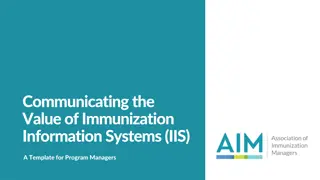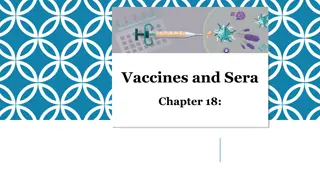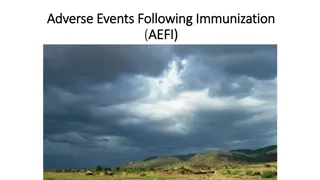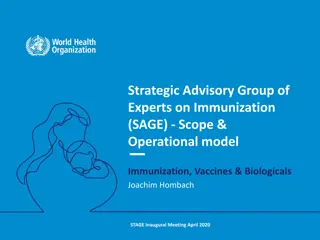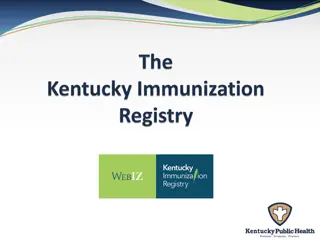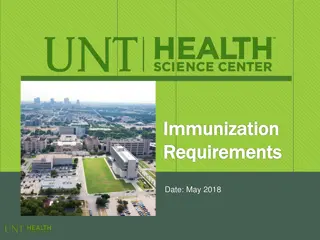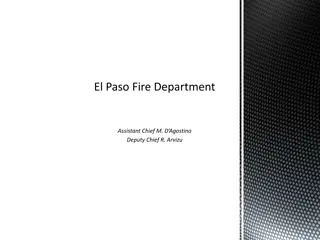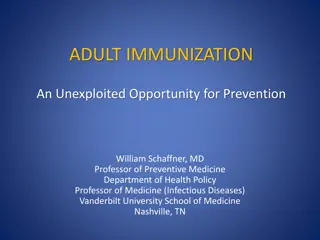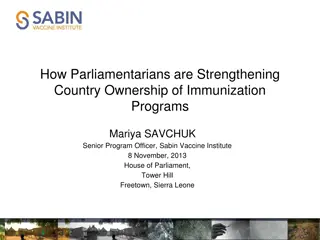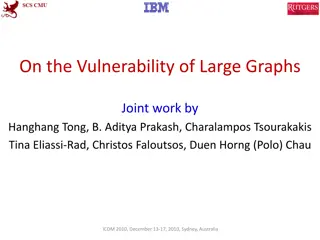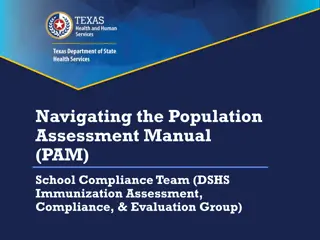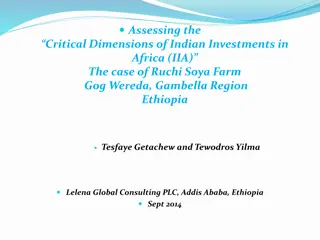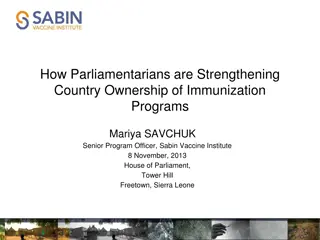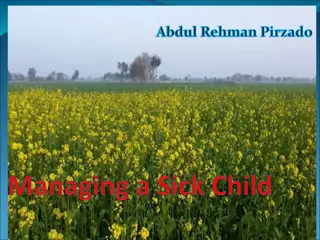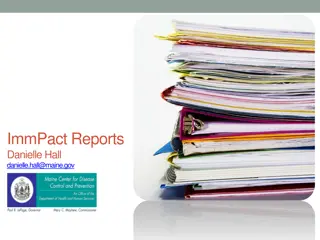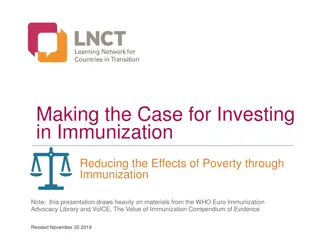Expanded Program on Immunization (EPI) Overview in Ethiopia
Communicable diseases are major causes of child mortality in Ethiopia. The EPI aims to provide immunization to infants and women of childbearing age. Learn about immunity, immunization, and vaccination targets. Explore the types of immunity and ways EPI promotes active and passive acquired immunity through vaccination. Understand the role of antigens, antibodies, toxoids, and antitoxins in boosting immunity against diseases
Download Presentation

Please find below an Image/Link to download the presentation.
The content on the website is provided AS IS for your information and personal use only. It may not be sold, licensed, or shared on other websites without obtaining consent from the author.If you encounter any issues during the download, it is possible that the publisher has removed the file from their server.
You are allowed to download the files provided on this website for personal or commercial use, subject to the condition that they are used lawfully. All files are the property of their respective owners.
The content on the website is provided AS IS for your information and personal use only. It may not be sold, licensed, or shared on other websites without obtaining consent from the author.
E N D
Presentation Transcript
Expanded Program on Immunization (EPI) RAHEL A 1
Overview Communicable diseases are the major causes of child mortality in Ethiopia The objective of EPI is making immunization available to all infants and women of childbearing age (15-49) RAHEL A 2
Overview.. Immunity: Is a resistance of the body against disease producing agent Immunization: Is the process of inducing immunity artificially. Vaccination: Is the administration of any vaccine or toxoid for prevention of disease. RAHEL A 3
Targets of EPI Infants (<1 year) and Women of childbearing age (15-49) RAHEL A 4
Immunity can be Innate or non specific immunity Is natural resistant of body E .g skin , mucus membrane, WBC, Tear Acquired/specific immunity Active acquired immunity Passive acquired immunity RAHEL A 5
Immunity Skin- protective covering MM- ciliated epithelium Non-Specific Secretion tears, GI secretion Reflex responses- coughing & sneezing Genetic resistant to P. falciparum Immunity following clinical /sub-clinical infection Natural Active Specific following vaccination Artificial Acquired Natural acquire via Trans-placenta e.g. malaria, TT Passive Artificial performed antibody sera is given e.g. TAT RAHEL A 6
EPI Active acquired immunity: The child body makes its own antibody Long lasting Can be:- Natural acquired Active immunity The child makes immunity after exposure to disease Artificial acquired Active immunity The child makes Ab after administration of vaccine (Ag) RAHEL A 7
EPI.. Passive acquired immunity: The child gets ready made Ab Short live immunity Can be Natural acquired passive immunity Transplacentally transferred maternal Ab into the child body E.g. malaria , measle , TT Artificial acquired passive immunity Formed Ab are administered to child RAHEL A 8
EPI Antigen: is a foreign substance that stimulates our body to produce antibody Antibody: is a substance which is produced by our body against the antigen Toxoids: are harmless toxins or poisons that are produce from bacteria (TT,DT) Antitoxins: Ab that units with and neutralizes a specific toxins used to provide passive immunity Vaccine : is suspension of live or killed MOS administered for prevention of specific infection RAHEL A 9
EPI There are 3 ways of vaccination strategies 1. Static site 2. Outreach site 3. Mobile vaccination RAHEL A 10
Types of vaccine Live attenuated vaccine: Is a weakened organisms that stimulated the body to produce Ab. Example: polio , measles , BCG Dead vaccine: Contain dead microorganism E.g pertussis Toxoids: Are harmless toxins or poisons that are produce from bacteria (TT, DT) RAHEL A 11
EPI Targets=10 disease Poliomyelitis Measles Tetanus Diphtheria Tuberculosis Pertussis HBV Hemophilus influenza B Rota Virus Pneumonia RAHEL A 12
Schedule Immunization schedules are determined by immunogenicity of the vaccine and epidemiology of the disease-when the disease occurs Good immunogenic vaccine need only one injection to produce long lasting immunity (Measles, BCG) Weak immunogens (DPT, cholera) require several injections to establish protective antibody levels- ensure protection against the disease RAHEL A 13
Schedule. Contact Age of the child Vaccine 1st vaccination At birth Polio 0 and BCG 2nd vaccination 6 wks Polio 1, pentavalent 1, rota 1, PCV1 Polio 2, pentavalent 2, rota 2, PCV2 Polio 3, pentavalent 3, PCV 3, IPV Measles, VitA 3rd vaccination 10 wks 4th vaccination 14 wks 5th vaccination 9 month RAHEL A 14
Schedule. Route & site Vaccine Dose No. of dose & age Side effect BCG <1yr 0.05ml >1yr 0.1 ml ID, right upper arm 1 , at birth or at any age - Local inflammation Small scar Deep abscess - - OPV 2 Drops PO , mouth 4 , at birth, 6,10,14 weeks None DPT- HBV-HIB (pentavalent) 0.5 ml 3, at 6 wks,10 wks, 14 wks Fever, local swelling , sometimes convulsion IM, anterior thigh Rota 1.5ml Po, mouth 2, at 6 & 10 wks 0.5ml IM, anterior thigh 3, at 6 wks,10 wks, 14 wks PCV IPV IM, thigh 2 cm below penta 1, 14wks Measles 0.5 ml Sc, Left upper arm 1, at 9 month or later Fever, rash RAHEL A 15
EPI.. Acceptable proof of immunization: BCG scar on the right upper arm Immunization card RAHEL A 16
Forms of vaccines Powder form = BCG and measles dilute 1ml and 5ml respectively Liquid form = polio, pentavalent , TT RAHEL A 17
TT Schedule Contact Minimal interval Duration of protection S/E TT1 At first contact during pregnancy or all women child bearing age (15- 49years At least 1month after TT1 3year 0 - Redness -pain, - swelling a few days at injection TT2 TT3 At least 6month after TT2 5year TT4 At least 1year after TT3 10year TT5 At least 1year after TT4 Life long RAHEL A 18
Vaccine problems Drop out A child or women who failed for return subsequent doses for which he/she is eligible Possible Cause of drop out Fail to explain the need of completing vaccination If the mother is busy Unsure the day of return Long wait at health center etc RAHEL A 19
Vaccine problems Dropout rate calculation (DR) Over all DR =coverage with BCG coverage with measles x 100 Coverage with BCG RAHEL A 20
Vaccine problems Dropout rate for single vaccine: Dropout rate of penta = coverage penta 1 pinta 3 X 100 Penta 1 Dropout rate of OPV = OPV0 OPV3 X 100 OPV0 RAHEL A 21
Vaccine problems There is a problem where the dropout rate is > 10% It is essential to determine why the failure occurred E.g. what is DPT drop out rate if DPT1 coverage 80% and DPT3 coverage 70%? DPT dropout rate = DPT1 DPT3 x 100 DPT1 80-70x 100 = 12.5% 80 RAHEL A 22
Cold Chain A System that ensures potency, quality and safety of Vaccines by maintaining the correct temperature from Manufacturer to target population Equipments and people together that keep vaccines cold during their journey You are the guardian of your vaccines RAHEL A 23
How long is the cold chain? Manufacturer to airport; cold storage at airport Correct temperature from airport to storage in central, regional and district stores and in health centers Transported at the correct temperature to outreach sites Kept at correct temperature during immunization sessions RAHEL A 24
What damage vaccine Heat and sunlight damage all vaccine but live attenuated vaccine ( BCG, measles and polio) most sensitive Freezing damage (pentavalent , TT) BCG most sensitive to sunlight The correct temperature of the refrigerator is 2 C0 - +8 C0 RAHEL A 25
Precaution All vaccines should store at 2-8 C0 Measle and polio kept frozen Never freeze pentavalent and TT Dilutants and vaccines should be kept in refrigerator RAHEL A 26
EPI.. Compartment of refrigerator for vaccine Top compartment = measles and polio ..highest coldness Middle compartment = BCG Lower compartment = pentavalent and TT 4th compartment if available for distilled water .. Lowest coldness RAHEL A 27
Vaccines sensitive to heat OPV Most sensitive Measles Least sensitive BCG TT Pentavalent RAHEL A 28
Vaccines sensitive to cold Most sensitive Pentavalent TT Least sensitive polio BCG measle RAHEL A 29
Vaccine Vial Monitoring(VVM) VVM is a temperature sensitive label that indicates whether the vaccine damage by heat or not. Every vial is distributed with a temperature-sensitive label, that health workers monitor during vaccination sessions If the inner square is lighter than the outer ring and the expiration date is valid, the vaccine is safe If the inner square matches or is darker than the outer ring, the vaccine must be discarded RAHEL A 30
RAHEL A 31



